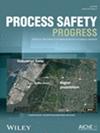Numerical simulation study on propane gas leakage and diffusion law in slope terrain
IF 1
4区 工程技术
Q4 ENGINEERING, CHEMICAL
引用次数: 0
Abstract
It is frequent that gas leakage accidents occur at chemical enterprises located in slope terrain. Meet the requirement of urgently studying the gas leakage and diffusion law in slope terrain. In this study, we utilize computational fluid dynamics (CFD) to simulate the scenarios of propane leakage and diffusion under four distinct slope conditions, which are 0°, 10°, 15°, and 20°. The gas diffusion law under different slopes is investigated, and the influence of wind speed and wind direction on the diffusion process is also further analyzed. The study indicates that when the slope exceeds 15°, the change in slope exerts a pronounced influence on the dispersion of propane leakage. Compared with diffusion on flat ground, there is a distinct propane aggregation area at the bottom of the slope terrain. Also, the steeper the slope, the more noticeable the aggregation phenomenon. The increase of wind speed makes propane gas lifted, and the gas aggregation at the bottom of the slope decreases. In particular, at a wind speed of 3.3 m/s, the aggregation of propane at the bottom of the first 15° and 20° slopes is more pronounced. Under the upwind condition, the propane gas is entrained at the slope surface, increasing the propane concentration in the area around the tank, which in turn increases the safety risk. The findings of this study have significant implications for the rational layout of chemical enterprises, gas leakage monitoring, and emergency evacuation planning for leakage accidents. They can also help enhance chemical enterprises' safety prevention abilities and the efficiency of their emergency response.斜坡地形中丙烷气体泄漏和扩散规律的数值模拟研究
位于坡地的化工企业经常发生气体泄漏事故。为满足急需研究坡地气体泄漏和扩散规律的要求。本研究利用计算流体动力学(CFD)模拟了 0°、10°、15° 和 20°四种不同坡度条件下丙烷泄漏和扩散的情景。研究了不同坡度下的气体扩散规律,并进一步分析了风速和风向对扩散过程的影响。研究表明,当坡度超过 15°时,坡度的变化对丙烷泄漏的扩散有明显的影响。与在平地上的扩散相比,在斜坡地形的底部有一个明显的丙烷聚集区。而且,坡度越陡,聚集现象越明显。风速的增加会使丙烷气体上扬,坡底的气体聚集减少。特别是在风速为 3.3 米/秒时,丙烷在第一个 15°和 20°斜坡底部的聚集现象更加明显。在上风条件下,丙烷气体夹带在斜坡表面,增加了储罐周围区域的丙烷浓度,从而增加了安全风险。本研究的结果对化工企业的合理布局、气体泄漏监测和泄漏事故应急疏散规划具有重要意义。同时也有助于提高化工企业的安全防范能力和应急响应效率。
本文章由计算机程序翻译,如有差异,请以英文原文为准。
求助全文
约1分钟内获得全文
求助全文
来源期刊

Process Safety Progress
工程技术-工程:化工
CiteScore
2.20
自引率
10.00%
发文量
99
审稿时长
6-12 weeks
期刊介绍:
Process Safety Progress covers process safety for engineering professionals. It addresses such topics as incident investigations/case histories, hazardous chemicals management, hazardous leaks prevention, risk assessment, process hazards evaluation, industrial hygiene, fire and explosion analysis, preventive maintenance, vapor cloud dispersion, and regulatory compliance, training, education, and other areas in process safety and loss prevention, including emerging concerns like plant and/or process security. Papers from the annual Loss Prevention Symposium and other AIChE safety conferences are automatically considered for publication, but unsolicited papers, particularly those addressing process safety issues in emerging technologies and industries are encouraged and evaluated equally.
 求助内容:
求助内容: 应助结果提醒方式:
应助结果提醒方式:


